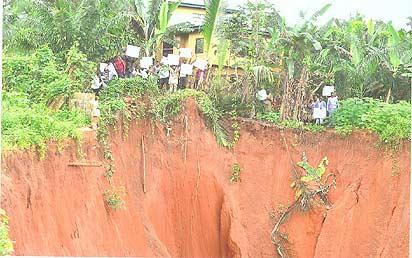
*One of the erosion-devastated sites. INSET: Protesting members of the community brandishing placards
The Federal Government said that 97 percent of Nigeria’s landmass remains undocumented, a development which has contributed to the country’s poor rating among comity of nations on the speed and efficiency of processes and procedures of land governance.
Secretary to the Government of the Federation, Senator Anyim Pius Anyim, stated this recently in his keynote address delivered at a workshop on land reform in Enugu. Anyim, who was represented by Senator Ben Collins Ndu, lamented that Nigeria has only duly documented land titles for 3 percent of the country’s total land mass of about 923,768 square kilometres. He noted that the consequence was that the land resources in Nigeria have not been put to optimum economic advantage.
According to him, appropriate titling and registration of parcels of land will enable holders to harness the wealth inherent in their land asset. He was pleased that the pilot systematic land titling and registration (SLTR) projects already embarked upon by the Land Reform Committee in collaboration with Ondo and Kano states government were yielding results.
Anyim commended international development partners like Growth and Empowerment in States (GEMS3) funded by DFID which has supported the projects in the states and embarked on similar projects in a few others.
“The pilot projects have proved that land titling could be transparent and quick. The process of recording every parcel in the presence of adjoining owners is also expected to significantly reduce litigations. We are expecting that the first set of Certificates of Occupancy shall soon be rolled out from the pilot projects.
The comprehensive inventory of land holdings across the country that would be generated from the ongoing titling projects shall also aid housing census and provide data for planning. It is pertinent to state that the greatest beneficiaries of the land reform programme are the states and local governments.

Disclaimer
Comments expressed here do not reflect the opinions of Vanguard newspapers or any employee thereof.